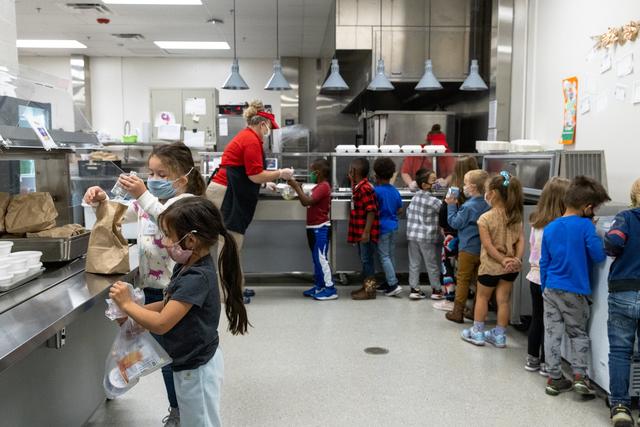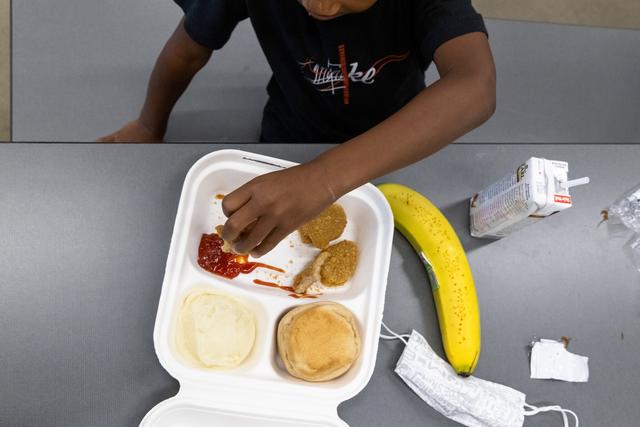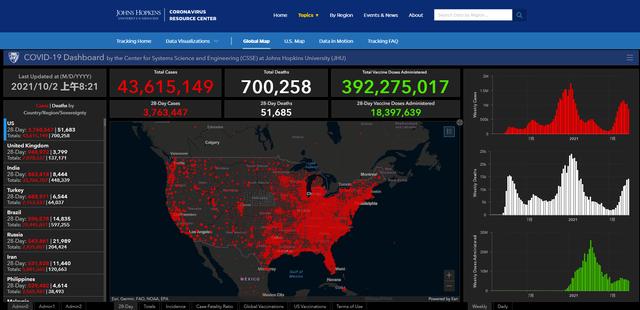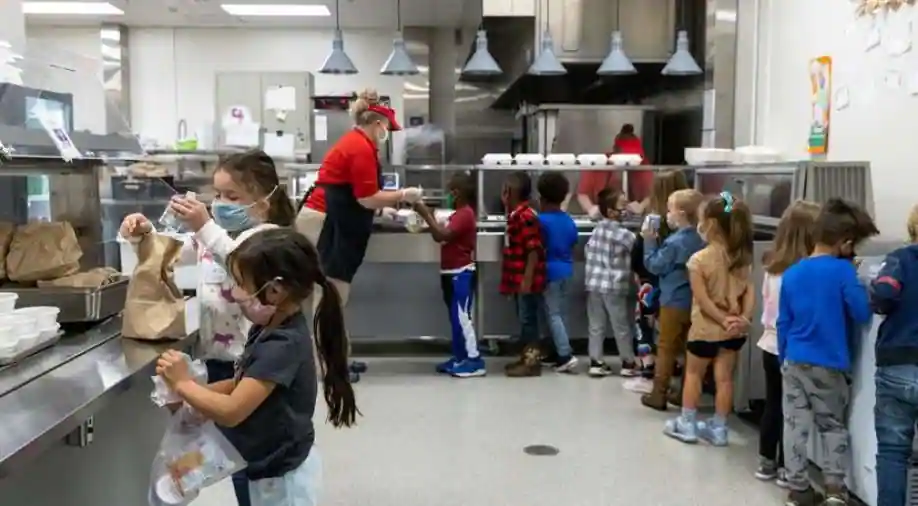30年未遇,全美各地学校食堂“缺粮”:没蔬菜没面包少叉子…
文章来源: 腾讯新闻
10/02/2021
“食堂没蔬菜了,吃点水果代替吧”“勺子叉子没了,用手抓吧”“自带午餐吧”……
新冠疫情肆虐在美国造成的劳动力短缺,已危及到了包括学校食堂在内的供应链。据美国《纽约时报》9月27日报道,美国全国各地学校正面临鸡肉、面包等食堂主食和塑料餐具的短缺,美国学生遭遇30年未遇的“吃饭难”问题。
尽管美国官员宣称,他们正在努力保障学校的食物供应,但许多美国教育工作者表示,预计供应链的问题在未来几个月内只会进一步恶化。
美国学校营养协会(SNA)针对5.5万名学校膳食营养工作人员的民调显示,约97%的受访者担心食物供应链可能持续中断。

美国遭受的供应链问题影响也已经超出学校食物不足的范畴。在疫情导致的运费不断涨价、劳动力持续短缺背景下,美国的零售商正在面临货物供应紧张、成本快速上涨等问题,美国消费者将不得不在未来一段时间内面对物价相对维持高位的局面。
没蔬菜、没面包、没叉子……

Tel: 551-580-4856 | Email: F.WINNIE.S@GMAIL.COM
密苏里州北堪萨斯城学校的食品和营养服务主任珍娜·克努特(Jenna Knuth)向《纽约时报》表示,在三家大型食品分销商停止向该学区供货后,她将无法获取足够的食物来满足当地2.15万名学生的需求。为此她和工作人员已经开始定期采购冷冻披萨、土豆泥和热狗,以备不时之需。
克努特说,批发商店的食品大多不符合美国政府的营养指导意见,但他们只能尽可能地筹备食物,她同时也在“恳求”当地分销商和供应商与她签订供货合同。
这样的情况在美国各地都不同程度地上演,例如弗吉尼亚州里士满的公立学校正在用低成本快餐食品替换食堂饭菜。
里士满宾福德中学一个名叫麦琪·科布(Maggie Cobb)的13岁学生说,她以前很喜欢自己学校做的披萨,但过去一个月她只能吃到粗制滥造的三明治,“这看起来很倒胃口。”
根据科布的说法,她以前每周至少两到三天都在学校吃饭,但如今她已经完全依赖母亲每天替她准备饭菜了。

密苏里州的利伯蒂公立学校则是自几周前开始,就鼓励学生和家长提前准备饭菜,自带午餐上学。
“如果学生在家里自备饭菜上学对你的家庭不构成负担,那么我们鼓励将其作为短期内的选择。”这家学校的通知如此写道。
明尼苏达州圣保罗市的官员更是已经开始储备奶酪三明治作为替代品。当地的营养服务主管斯泰西·科本(Stacy Koppen)透露,几周前这里的午餐汉堡面包饼就已经全部消耗光了,现在他们只能使用普通面包。
“我们预计无法在今年晚冬或明年初春能够放松警惕。”她说。
堪萨斯州奥拉西学区则出现了水果代替蔬菜的情况。
该学区负责食品服务的助理主任辛迪·琼斯(Cindy Jones)表示,8月蔬菜配送出现了延误,导致学区有两天时间没有蔬菜供应,当时学区只能鼓励学生多吃水果。她还说,学区的食物订单往往都不能全部送达,送货的卡车通常只能送到65%的订单。
除饭菜外,一次性勺子、刀叉等餐具也面临短缺的困境,许多美国学校不得不学会什么叫做节约。
《纽约时报》举例称,得克萨斯州达拉斯独立学区通常会储备够用1个月的餐具,但该学区近期只能维持9天的餐具储备。因此该学区现在每周二的早午餐都只提供可以直接用手拿着吃的食物。
该学区食品和儿童营养服务执行主任迈克尔·罗森伯格(Michael Rosenberger)表示,这样的情况已经至少30年没有发生过了,“我做这行30年,从未见过供应链如此混乱。”

“吃饭难”的背后,是疫情对供应链的打击
这场突如其来的“吃饭难”问题,实际上与美国严重的新冠疫情有着密切关联。在疫情的冲击下,学校食品供应的每一环几乎都遭遇了劳动力不足的问题。首当其冲的就是美国食品分销商和制造商,劳动力短缺导致这些公司的生产线缺乏人手,也没有足够多的司机开车送货。
《纽约时报》举例称, 纽约州布法罗的理奇食品公司承担着为2000多个学区生产食品的任务,但该公司高管凯文·斯普拉特(Kevin Spratt)向美媒抱怨说,工厂没有足够的劳动力满足需求,原材料和包装材料供应也十分紧张,他们已被迫暂停了15种产品生产,转而向学校提供几种“替代产品”。
卡车司机数量的紧张也是导致供应链问题的关键因素。
例如纽约州哈德逊市金斯伯格食品公司CEO苏珊·拉杰齐(Suzanne Rajczi)表示,该公司的司机和仓库工人严重不足,不得不放弃大约80个学区的供应业务,并缩短对其他学校供应服务的时间。
劳动力短缺的问题接着又直接影响到各个学区。报道提到,一些学区没有足够的工人来准备食物,这使得学区内的学校既没有能力为学生准备热的饭菜,又缺乏必要的人手来规划和准备每一天的菜单。
供应短缺同样不可避免地造成了成本上升的问题。堪萨斯州奥拉西学区负责食品服务的助理主任辛迪·琼斯称,随着经销商将价格上涨的成本转嫁给消费者,食物成本也一路飙升。这导致他们只剩下两个选择,“要么面对挨饿的风险,要么接受高昂的价格。”
“当然,我们会照顾好孩子们,但这个问题也是我们的一大担忧。”琼斯说,“如果我们得不到足够的补偿和资金来支付这些额外成本,那将来我们又要怎么办呢?”

但对于当前的困境,美国政府的应对措施却很有限。据美国有线电视新闻网(CNN)报道,美国农业部宣布拨款15亿美元帮助各州及各地学校采购食物,并推出豁免令宣布因供应链问题而无法满足膳食标准的学校可以免受处罚。
然而大部分教育工作者仍对前景持怀疑态度。《纽约时报》称,许多教育工作者都预计未来几个月的情况只会继续恶化。
美国学校营养协会(SNA)针对5.5万名学校膳食营养工作人员的民调也显示,约97%的受访者担心食物供应链可能持续中断。
美国营养与饮食学会高管利兹·坎贝尔(Liz Campbell)悲观地表示:“现在有供应链问题,食品分销商问题,劳动力不足问题,司机短缺问题,每周都有新的。那下一个是什么呢?”
供应链问题已造成全方位影响
事实上,新冠疫情带来的美国劳动力短缺和供应链中断问题所造成的影响,早已远远超出学生“吃饭难”的范畴。美媒指出,随着全球多地工厂在疫情的冲击下关门歇业,美国许多公司正面临商品库存不足的窘境,这进而导致发货延迟、成本上升等问题。
美国消费者新闻与商业频道(CNBC)近日报道称,在新冠疫情的影响下航运成本正以惊人的速度上涨,多家美国零售企业已经发出警告,称近期美国消费者可能还要继续面对物价上涨的问题。

报道指出,在新冠疫情暴发前,将一个12米长的集装箱从上海运到纽约的成本大约在2000美元,但美国银行的数据显示现在这样跑一趟需要至少16000美元。运费的飙升和供应链环节的危机,正导致美国公司出现“供货难”的现象,运动服装品牌耐克、美国零售商Costo等业界巨头都表示了类似担忧。
Costo首席财务官理查德·加兰蒂(Richard Galanti)在近日一场电话会议上估算,Costo销售的纸制品成本已经上涨4%至8%,塑料和宠物用品的短缺更是将其价格抬高了5%至11%。加兰蒂警告说,供应链问题造成的运费、劳动力成本、运输和产品上涨都对产品价格上涨起到推波助澜的作用。
供应链环节问题同样严重影响美国物流行业。报道称,美国联邦快递因劳动力短缺等压力,上周宣布将美国国内服务的运费上调5.9%,其他业务运费上调7.9%。其竞争对手UPS的CEO卡罗尔·托梅(Carol Tome)也表示,UPS为应对市场需求同样作出价格调整,她坦言公司正受到供应链紧张的打击。
更麻烦的问题在于,这一系列供应链问题出现在了一个微妙的时机,万圣节、圣诞节等美国假日购物季即将到来,美国零售商必须设法备足货物。但美国《华盛顿邮报》指出,如今美国“扭曲”的供应链正迫使企业发出“预防性订单”以避免商品售罄,但这只会反过来加剧供应链压力。
美国咨询公司伯克利研究集团全球零售业务负责人基思·耶利内克(Keith Jelinek)告诉CNBC,商品成本、集装箱成本、运输成本的增加都在打击美国零售商的营业利润,“零售商现在面临的挑战是,我能向消费者提供多少商品?又能否通过更多努力来赚取更多利润?”
不过CNBC也提到,许多公司发现,由于美国政府在疫情期间提供一些经济刺激措施,因此美国多数消费者目前依然愿意接受涨价。耶利内克预计,这种情况可能持续到圣诞节,但没人知道这种情况还能维持多久。
由于疫情仍在美国持续肆虐,美媒也不敢断言供应链问题何时会出现好转。“很多人都认为这是一个过渡的年份,下个学年一切会恢复正常。”坎贝尔说,“去年很多人也是这么想的,但在‘德尔塔’病毒和其他许多事情的影响下,今年的情况几乎比去年更糟。”
就在美国供应链情况日益紧张的同时,美国疫情的状况也在持续恶化,死亡人数已经突破70万。根据美国约翰斯·霍普金斯大学统计数据,截至北京时间2021年10月2日8时21分,美国新冠肺炎累计确诊病例达43615149例,累计死亡病例超70万例,达700258例。

No veggies, no buns, few forks: Schools scramble to feed students amid shortages
By Madeleine Ngo
10/02/2021

A lunch line at Rising Hill Elementary in Kansas City, Mo. on Sept. 23, 2021, where the school district has had to make supply runs to Sam’s Club and Restaurant Depot stores because of shortages from food distributors. Schools across the country are offering less healthy lunch options as they struggle with dwindling supplies, delayed shipments and fewer cafeteria workers. (Katie Currid/The New York Times) Photograph:( The New York Times )
School officials in a Missouri city have been making twice-weekly runs to Sam’s Club to stock up on frozen pizzas and hot dogs. A Kansas school district ran out of vegetables for two days last month. And a district in St. Paul, Minnesota, has an emergency supply of frozen grilled cheese sandwiches in case it runs out of all other food.
Schools across the country are facing shortages of cafeteria staples like chicken, bread, apple juice and even plastic cutlery, as supply chain woes and a lack of truck drivers complicate the most basic task of feeding students.
Officials say they are scrambling to provide meals for students — many of whom rely on the food they eat at school as a significant, and sometimes the only, source of daily nutrition. Many educators say they expect supply-chain issues will only worsen in the coming months.
The issue stems from a confluence of events, much of it tied to the pandemic. Labor shortages have rocked food distributors and manufacturers, who say they do not have enough people to drive trucks, pull products from warehouses or work assembly lines. The virus has exacerbated the country’s shortage of truck drivers, and companies say they do not foresee enough young drivers applying to replace those aging out of the workforce.
Jenna Knuth, the director of food and nutrition services at North Kansas City Schools in Missouri, grew worried that she would not have enough food to feed all 21,500 students in her district after three big food distributors said they would stop delivering supplies. So Knuth’s staff members are making regular trips to the local Sam’s Club and Restaurant Depot stores, where they clear out the frozen pizzas, tater tots and hot dogs.
Many of the products they buy at the wholesale stores do not meet federal nutritional guidelines, Knuth said, adding that while the food is not unhealthy, it contains higher levels of sodium and fat than the products the district would usually purchase.
“We’re bringing in whatever food we can,” Knuth said. She is now “begging” local distributors and suppliers for contracts.
Since the start of the pandemic, the Agriculture Department has issued a slate of waivers giving schools more flexibility to meet federal nutritional guidelines. On Sept. 15, the department issued a new waiver preventing school meal programs from being financially penalized if they fail to meet the guidelines because of supply-chain issues. It has also increased the rate it will reimburse schools for the cost of food products.
Six Spaces Home Staging

Contact: Hongliang Zhang
Tel: 571-474-8885
Email: zhl19740122@gmail.com
“We know that districts are doing everything they can to put healthy, nutritious food on the plate for kids,” said Stacy Dean, the department’s deputy undersecretary for food, nutrition and consumer services. “We want to support that effort and reassure them that no one is going to get in trouble because of an unexpected difficulty.”
Beth Wallace, the president of the School Nutrition Association, said the group was asking federal officials to further increase the reimbursement rate and temporarily loosen requirements that certain products be American-made. According to a recent survey conducted by the association, 97% of school meal program directors reported having concerns about supply-chain disruptions.
Cindy Jones, the assistant director of food services at the Olathe School District in Kansas, said schools there ran out of vegetables for two days last month after a delivery was delayed. The district encouraged students to take extra fruit instead.
When delivery trucks do arrive, they often do not carry all of the food the district ordered, Jones said, adding that Olathe was receiving only about 65% of its orders.
The cost of food has also spiked as distributors pass on price increases. At times, the district does not know how much a delivery will cost until the truck pulls up to the dock, forcing the district to either accept whatever the price is or risk running out of food, Jones said.
“Of course, we’re going to take care of the kids, but that’s one of our worries,” she said. “If we don’t get enough reimbursement and funding to pay for these additional costs, what is that going to do for us down the road?”
Supply-chain disruptions have snarled more than just school lunches. Coronavirus outbreaks have shut down factories around the world, leaving many companies light on inventory. That has led to delays in shipments, rising costs and shortages of a wide range of goods, including computer chips, bicycle parts and place mats.
At Liberty Public Schools in Missouri, district officials sent a note on Sept. 13 encouraging parents to send their children to school with packed lunches.
“If sending your student(s) to school with meals from home is not a burden for your family, we would encourage this option as a short-term request,” the note read.
Richmond Public Schools in Virginia replaced hot lunches with “grab and go” meals this year because of a shortage of food workers and concerns about the virus spreading.
Maggie Cobb, 13, an eighth grader at Binford Middle School in Richmond, said she used to eat at school two or three times a week. She especially liked the school’s pizza, back when meals were hot. But after she picked up lunch this month and saw that it contained an unappealing sandwich with deli meat that she could not identify, she decided she could no longer count on the school for food.
“It just looked gross,” she said. Her mother, Emily Kavanaugh, said she was now packing Maggie’s lunches for school.
Matthew Stanley, a spokesman for Richmond Public Schools, said in a statement that the district was working with its vendor to “quality-check all meals” and recruiting more school nutrition workers to resume hot lunches.
St. Paul officials have begun stockpiling grilled cheese sandwiches and making substitutions on the fly, said Stacy Koppen, the director of nutrition services.
A few weeks ago workers making hamburgers for lunch ran out of buns and had to switch to regular bread.
“We’re not really expecting to let our guard down until late winter or early spring,” Koppen said.
The shortages are not limited to food: A dearth of disposable spoons, forks and knives has forced some schools to begin conserving flatware.
At the Dallas Independent School District, schools now offer mostly finger foods for breakfast on Tuesdays and Thursdays to reduce the need for plastic cutlery. The district, which normally has about a month’s worth of cutlery stocked up, is now down to a nine-day supply. On Tuesdays, all lunches across the district consist solely of finger foods and no flatware is offered.
Instead of tossed salad and apple sauce, students will get carrot sticks and apple slices. And in place of spaghetti and meatballs, chicken tenders are offered.
“I’ve never seen the supply chain in this much chaos, and I’ve been doing this for 30 years,” said Michael Rosenberger, the district’s executive director for food and child nutrition services.
Worker shortages have compounded the problem, crippling both food distributors and manufacturers.
Suzanne Rajczi, the chief executive of Ginsberg’s Foods in Hudson, New York, said the distributor had to drop about 80 school districts because it lacked enough drivers and warehouse workers. Even for the schools it is continuing to work with, the company had to cut back delivery times.
(STORY CAN END HERE. OPTIONAL MATERIAL FOLLOWS.)
The Rich Products Corp., a manufacturer in Buffalo that supplies food to more than 2,000 school districts, is struggling to hire workers, said Kevin Spratt, a senior vice president who leads the company’s K-12 team. Several of its plants have as many as 50 positions open.
The labor shortages on top of a scarcity of ingredients and packaging materials have made it more difficult for the company to fulfill its orders. It has paused production on about 15 products it usually sells to schools, Spratt said, though it has been able to offer substitutions.
“We don’t have enough labor in our facilities to keep up with the demand,” Spratt said.
The labor shortage has trickled down to schools as well. Andrew Mergens, the senior director of student nutrition at the Anchorage School District, said the district could not provide hot meals in seven of its schools because there were not enough workers to prepare and serve the food. Instead, the district is offering prepackaged, shelf-stable meals for lunch.
“As you can imagine, shelf-stable meat isn’t great, but it’s all we got,” Mergens said.
Even where Anchorage is able to offer hot meals, it has become difficult to plan and prepare menus. Scrambling to make substitutions has started to weigh on the district’s staff: Four cafeteria managers have quit since the school year started, he said.
“They feel underappreciated,” Mergens said. “Nobody really understands how much of an impact the cafeteria manager has on the day-to-day operations of the school until they’re not there.”
哈佛教授沃尔特:四个要点说明美国的好运即将用尽
文章来源: 星岛日报
01/31/2021
《外交政策》杂志近日刊出美国哈佛大学国际关系教授沃尔特的评论认为,美苏上个世纪冷战的结果是出现了短暂的单极世界,全世界已没有任何强大的竞争对手能挑战美国,可今天还是这样吗?美国人现在还能继续认为世界就是他们的囊中之物吗?不管他们表现得如何不负责任,事情总是会好起来?可能是,但也可能不是。以下为沃尔特的论点,以四个原因解释为什么说美国的好运可能正在耗尽:
首先,美国自建国以来所享有的自由安全已不像过去那么稳固。举个现成的例子:在不到一年的时间里,新冠病毒的致死人数已超过了美国在一战、朝鲜战争和越南战争期间的战死人数总和。而且我们还得知,有一股外国势力(一般认为是俄罗斯)最近非法侵入了大量政府信息系统,其中许多系统还是美国国家安全体系的一部分。
第二大隐忧是中国,这是一个比前苏联更强大的对手。从1776年到上世纪90年代中期,美国人可能收获到了一长串胜利,但自那以后,中国的成绩单更为亮眼。中国的经济规模将很快大幅超过美国,它早已远离毁灭性战争的威胁,其统治精英也相信他们注定会成为本世纪的一大(如果不是唯一的)领导力量,他们的制度模式总体运行良好,他们充分参与关键国际机构的活动中并出现在这个世界的每一个地区。
质疑美国是否会持续走运的第三个依据是,美国人已开始自己伤害自己。伤害清单很长:故意制造出来的两极分化以及由此产生的政治僵局使得美国难以及时采取行动去应对重大问题;对“自由”盲目崇拜以至于数百万美国人认为在疫情期间拒不佩戴口罩不是愚蠢的行为而是英雄壮举等等。
还有气候变化。如果大气层继续升温,那么无论多么有利的地缘政治条件都无法拯救美国。拥有一个庞大的经济体、一群训练有素的科学家和工程师以及一个具有创新能力的私人部门,可能有助于美国以各种方式减轻、适应和调整环境问题带来的压力,但他们所要应对的挑战却每年都会变得更加严峻。
VOICE
America’s History of Luck Is Running Out
The country’s rise was fueled by fortunate circumstances that seem unlikely to last much longer.
BY STEPHEN M. WALT | DECEMBER 23, 2020

The United States is the luckiest country in modern history. It began as a set of marginal European outposts, separated from the settlers’ home countries by a difficult sea voyage. When the colonies gained independence, they were weak, poor, and fractious. But in less than a century and a half, those 13 original colonies had expanded across North America, survived a civil war, driven other great powers from the Western Hemisphere, and created the world’s largest and most dynamic economy. That ascent didn’t stop until the end of the 20th century, when victory in the Cold War left the United States alone at the pinnacle of power. For a little while.
Americans like to attribute this remarkable story to their ancestors’ virtues, the enlightened wisdom of the Founding Fathers, and the intrinsic merits of America’s peculiar blend of liberal democratic capitalism. But in addition to the considerable cruelty displayed toward the native population and the slaves imported from Africa, good fortune played a major role as well.
Americans were fortunate that North America was rich with natural resources and fertile land, traversed by navigable rivers, and had a mostly temperate climate. And from the very beginning, the United States benefited from rivalries among the existing great powers. France backed the American Revolution in order to weaken its British rival, and the new nation doubled its territory when Napoleon needed money to wage war in Europe and was willing to sell the Louisiana Purchase at a bargain price. War in Europe also helped the United States survive its foolish decision to invade Canada in the War of 1812; Britain was too busy defeating Napoleon to turn its full strength against its obnoxious former colonists. The United States gradually attracted more attention as it expanded across the continent and took Texas, New Mexico, Arizona, and California from Mexico, but the European powers spent most of the time competing with each other and for the most part left the United States alone. By 1900, British concerns about a rising Germany led them to abandon their territorial claims in the Pacific Northwest and South America and appease the United States. And at that moment, the Monroe Doctrine of 1823 became a reality.
Indeed, no other great power has enjoyed the so-called free security that America has possessed since its founding. Apart from Britain, every other major power has been invaded at least once in the past 200 years, and several of them have been conquered and at least temporarily occupied. Even Britain lost some 50,000 civilians to German bombings during World War II. Foreign troops last occupied U.S. soil during the War of 1812, and the continental United States was effectively unscathed during the two world wars that decimated Europe and Asia during the 20th century. That free security also permitted the United States to be the last major power to enter both wars, to suffer the fewest losses, and to emerge in a dominant position when the fighting stopped.
To be sure, U.S. leaders also made some smart decisions that took advantage of these lucky breaks. They adopted a constitution that privileged individual freedom and spurred the creation of a boisterous capitalist economy. They opened the continent to immigrants from all over the world and managed to contain the frictions that waves of immigrants occasioned. And while the shameful legacy of slavery continues to blight the American experience, the North’s victory in the Civil War prevented a permanent division of the continent and allowed the reunited country to reach its full power potential.
Since becoming a great power, the United States has also been fortunate in its choice of enemies. Imperial Germany was a daunting military power, but its armed forces had been depleted by the time the American Expeditionary Force arrived in 1918. The Nazi Wehrmacht was even more capable, but Adolf Hitler was an incompetent strategist, and the Soviet Union did most of the work to defeat Germany anyway. Imperial Japan’s economy was roughly a fifth the size of America’s in 1941, its wartime leadership was deeply divided, and it already had thousands of troops bogged down fighting in China. World War II in the Pacific was hardly a cakewalk, but the outcome was not in doubt once the United States mobilized for war.
The Soviet Union was by far America’s most formidable adversary, but the deck was still heavily stacked in America’s favor. The Soviet economy was significantly smaller, its allies were much weaker and less reliable, and it faced serious rivals on several frontiers while America sat unthreatened in the Western Hemisphere. The Soviet command economy was a wonderland of waste and inefficiency, and Soviet leaders had to devote a much higher percentage of GDP to defense just to keep the United States in sight. Mikhail Gorbachev’s belated efforts to reform the system failed, and the Soviet Union collapsed not with a bang but with a whimper.
The result was a brief unipolar moment when the United States faced no serious rivals and both politicians and pundits convinced themselves that America had found the magic formula for success in an increasingly globalized world. The hubris of the 1990s was to be expected, perhaps: No other country could claim such a long and mostly unbroken run of success, where ill fortune never seemed to hold the country back for long.
Is this still the case today? Can Americans continue to assume that the world is their oyster and that things will always turn out right no matter how irresponsibly they seem to behave?
Maybe, but maybe not. Here are four reasons why the United States’ luck just might be running out.
First of all, the free security that the nation has known since its founding is not quite as profound as it used to be. Don’t get me wrong: Having no serious enemies nearby is still a considerable benefit, and those two vast oceanic moats still protect the United States from a fair number of potential problems. The Pentagon is formally the “Defense Department,” but America’s armed forces don’t spend much time or money defending U.S. soil directly. Instead, they go into harm’s way in order to try to shape political conditions in a host of faraway places. Why can they do that? Because Americans don’t have to worry about an invasion from Canada or Mexico—or anybody else.
Unfortunately, 2020 has given us a grim reminder that the protection the United States once enjoyed is not as ironclad as it once was. Case in point: In less than a year, the coronavirus has killed more Americans than World War I, the Korean War, and the Vietnam War combined. As I write this, the daily death toll in the United States is larger than the number of Americans killed on 9/11. Distance still matters, but it does not protect against every danger.
We also learned last week that a foreign power (generally believed to be Russia) has hacked into a vast array of government computer systems, including many that are part of the U.S. national security establishment. The full extent of the damage is still unknown, but the incident illustrates another vulnerability that distance cannot diminish. The United States is still fortunate to be located where it is, but that advantage is not as great as it once was.
The second cause for concern is China, which is a far more formidable rival than the Soviet Union ever was. Americans may have racked up a long winning streak from 1776 to the mid-1990s, but China boasts a much better record since then. China’s economy will soon be substantially larger than that of the United States, it has stayed out of ruinous wars, its ruling elites believe they are destined to be a (if not the) leading power in this century, their model of single-party state capitalism has generally worked well, and they are fully engaged in key international institutions and in every region in the world. While the Trump administration has been busy flirting with various forms of protectionism, China has been negotiating and signing new trade and investment deals. Beijing’s mishandling of the coronavirus outbreak allowed it to spread abroad, but its subsequent response (and the cooperation of the population) has kept its own death toll below a reported 5,000 lives (in a country of 1.4 billion people). As a result, the Chinese economy is back open for business. The United States had more time to prepare for the pandemic, but the number of dead is well over 300,000, and the U.S. economy is still devastated by lockdowns and other pandemic-related restrictions.
The challenge China poses could be overstated. China’s per capita income is still significantly lower than America’s, and its new power surplus (i.e., the amount of wealth that can be mobilized to shape events elsewhere once domestic needs are met) is smaller. Its splashy Belt and Road Initiative hasn’t gone nearly as well as Xi Jinping hoped, and its recent embrace of belligerent “wolf warrior” diplomacy and its heavy-handed approach toward dissidents, trading partners, and its Uighur minority have sparked growing concerns about China’s long-term intentions. Even so, only an incurable optimist would assume that China will fall by the wayside as readily as America’s earlier rivals did.

A third reason to wonder about the United States’ continued good fortune is the series of wounds Americans decided to inflict on themselves. The list is long: the ; the deliberately manufactured polarization and the resulting gridlock that makes timely action on vital issues difficult to impossible; the fetishizing of “liberty” to the point that millions of Americans think refusing to wear a mask in the middle of a pandemic is not stupid but heroic; the enduring public prominence of a phalanx of liars, charlatans, and trolls who have built lucrative careers spewing a toxic blend of falsehoods and hatred; the pervasive influence of well-funded lobbying organizations whose commitment to truth is paper-thin; the distorting impact of money in U.S. politics and a ramshackle electoral system that increasingly enshrines minority rule; and a foreign-policy elite that is largely free from accountability and seems incapable of learning from past mistakes. I could go on, but you get the idea.
And then there’s climate change. The atmosphere doesn’t care what you or I happen to think about this problem; it’s going to follow the laws of physics and chemistry no matter what we choose to believe. Humans are free to deny the reality of climate change, but the planet isn’t paying attention. Favorable geopolitics won’t rescue the United States if the atmosphere keeps heating up (though some other countries will face even greater hardships), and having big-deck aircraft carriers, sophisticated ballistic missiles, state-of-the-art anti-submarine warfare or cyberwarfare capabilities, and the other trappings of a modern great power won’t help on this front either. A large economy, well-trained scientists and engineers, and an innovative private sector may help the country mitigate, adapt, and adjust in various ways, but the challenges they will have to address grow ever more daunting each year. When you marry what is happening to the planet to the political dysfunctions discussed above, it’s easy to imagine how the United States’ long run of good fortune could come to a sad end in a generation or two.

Am I being too gloomy? I hope so. The United States retains many strengths—especially in science and technology—and its potential rivals face serious problems of their own. A return to the unchecked primacy of the 1990s is not in the cards, but intelligent reforms could go a long way to preserving the security and prosperity of the country along with its core political values. The imminent departure of the Worst President Ever will surely help.

Branch Rickey famously remarked that “luck is the residue of design.” Americans should no longer assume that success is simply their birthright or that Otto von Bismarck was right when he reportedly quipped that there is “special providence for fools, drunkards, and the United States of America.” If Americans want to enjoy a future as favorable as their past, it will take a willingness to work together that has gone missing for a couple of decades. If they can’t bring it back, the United States’ long run of luck is likely to come to an end.
Stephen M. Walt is the Robert and Renée Belfer professor of international relations at Harvard University.
Source: https://foreignpolicy.com/2020/12/23/americas-history-of-luck-is-running-out/





